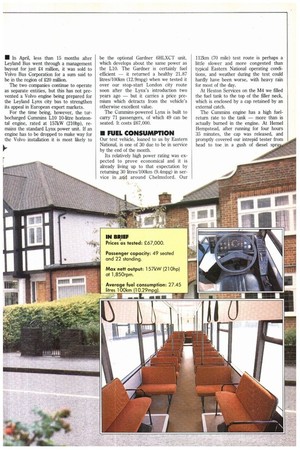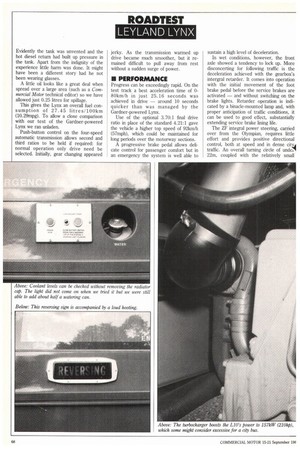ADDING MORE TO USE LESS
Page 56

Page 57

Page 58

Page 59

If you've noticed an error in this article please click here to report it so we can fix it.
The L-1 0 Cummins engine specified for the Leyland Lynx city bus follows current HGV practice by delivering more power than might seem necessary, in an attempt to improve efficienc
• In April, less than 15 months after Leyland Bus went through a management buyout for just .£4 million, it was sold to Volvo Bus Corporation for a sum said to be in the region of £20 million.
The two companies continue to operate as separate entities, but this has not prevented a Volvo engine being prepared for the Leyland Lynx city bus to strengthen its appeal in European export markets.
For the time being, however, the turbocharged Cummins L10 10-litre horizontal engine, rated at 157kW (210hp), remains the standard Lynx power unit. If an engine has to be dropped to make way for the Volvo installation it is most likely to be the optional Gardner 6HLXCT unit, which develops about the same power as the L10. The Gardner is certainly fuel efficient — it returned a healthy 21.87 litres/100km (12.9mpg) when we tested it over our stop-start London city route soon after the Lynx's introduction two years ago — but it carries a price premium which detracts from the vehicle's otherwise excellent value.
The Cummins-powered Lynx is built to carry 71 passengers, of which 49 can be seated. It costs £67,000.
• FUEL CONSUMPTION
Our test vehicle, loaned to us by Eastern National, is one of 30 due to be in service by the end of the month.
Its relatively high power rating was expected to prove economical and it is already living up to that expectation by returning 30 litres/100km (9.4mpg) in service in arid around Chelmsford. Our 112km (70 mile) test route is perhaps a little slower and more congested than typical Eastern National operating conditions, and weather during the test could hardly have been worse, with heavy rain for most of the day.
At Heston Services on the M4 we filled the fuel tank to the top of the filler neck, which is enclosed by a cap retained by an external catch.
The Cummins engine has a high fuelreturn rate to the tank — more than is actually burned in the engine. At Hemel Hempstead, after running for four hours 35 minutes, the cap was released, and promptly covered our intrepid tester from head to toe .in a gush of diesel spr Evidently the tank was unvented and the hot diesel return had built up pressure in the tank. Apart from the indignity of the experience little harm was done. It might have been a different story had he not been wearing glasses.
A little oil looks like a great deal when spread over a large area (such as a Commercial Motor technical editor) so we have allowed just 0.25 litres for spillage.
This gives the Lynx an overall fuel consumption of 27.45 litres/100km (10.29mpg). To allow a close comparison with our test of the Gardner-powered Lynx we ran unladen.
Push-button control on the four-speed automatic transmission allows second and third ratios to be held if required: for normal operation only drive need be selected. Initially, gear changing appeared jerky. As the transmission warmed up drive became much smoother, but it remained difficult to pull away from rest without a sudden surge of power.
• PERFORMANCE
Progress can be exceedingly rapid. On the test track a best acceleration time of 080km/h in just 25.16 seconds was achieved in drive — around 10 seconds quicker than was managed by the Gardner-powered Lynx.
Use of the optional 3.70:1 final drive ratio in place of the standard 4.21:1 gave the vehicle a higher top speed of 92Iun/h (57mph), which could be maintained for long periods over the motorway sections.
A progressive brake pedal allows delicate control for passenger comfort but in an emergency the system is well able to sustain a high level of deceleration.
In wet conditions, however, the front axle showed a tendency to lock up. More disconcerting for following traffic is the deceleration achieved with the gearbox's intergral retarder. It comes into operation with the initial movement of the foot brake pedal before the service brakes are activated — and without switching on the brake lights. Retarder operation is indicated by a binacle-mounted lamp and, with proper anticipation of traffic conditions, it can be used to good effect, substantially extending service brake lining life.
The ZF integral power steering, carried over from the Olympian, requires little effort and provides positive directional control, both at speed and in dense cityi traffic. An overall turning circle of under 22m, coupled with the relatively small 458mm (18in) steering wheel giving 5.5 turns lock to lock, makes easy work of urban manoeuvring.
• PASSENGER COMFORT
Entry for passengers is made easy with a wide (1.13m) single door opening, with hand rails on either side and a low splitstep height of 0.32/0.35m, and a tow second step of 0.19/0.16m.
The step edges can prove slippery to wet rubber-soled shoes, however. Inside, the floor slopes upward towards the rear by 450mm over the length of the vehicle. The floor area is clear and, like the Melamine side panels and black aluminium window frames, should be easy to clean.
Noise levels throughout the passenger cbmpartment remain at an acceptably low level under all conditions.
In Eastern National livery the Lynx body looks smart, but already during the test there were signs of movement be tween the exterior butt-joined panels, and in exceptionally wet conditions the front wheel arches allowed water into the saloon. Rear and side panels at the back of the bus allow access to the engine.
• CAB COMFORT
The small angle adjustment of the steering column will rarely be altered once set. Full air suspension gives a firm and level ride with only the smallest amount of roll. Passengers will find the ride comfortable, seated on moquette-covered regulation upholstered bus seats, but it must be questioned if the basic fixed drivers seat is adequate for a full duty rota.
Leyland's ergonomically designed cab places all instruments within easy view ahead of the driver and puts switches and controls within easy reach. Visibility through the• large windows is generally good but we would prefer to see a larger rear-view mirror_ Rear visibility in the wet conditions was often less than we liked.
The angled front split screen is rather ugly but has a practical advantage, having been designed to minimise reflectons from saloon lighting.
• SUMMARY
The high power-to-weight ration provided by the 10-litre Cummins engine might be considered excessive in a bus application, but as in the CV application, increased power is proving to be fuel efficient. Projected engine life expectancy is 225,000km. The fastest final-drive ratio extends the Lynx's appeal by making it more acceptable for private hire. The vehicle is both quiet and comfortable to ride in or drive. Access is as low as can practicably be engineered and the doors are wide, but the steps might be supplied with safer grip.
Overall the Cummins-powered Lynx is a workmanlike vehicle and should serve Eastern National well.
0 by Bill Brock






























































